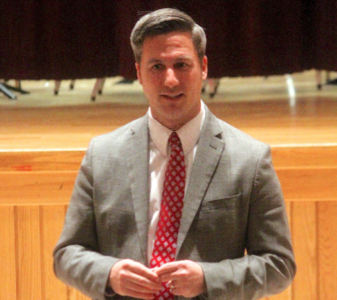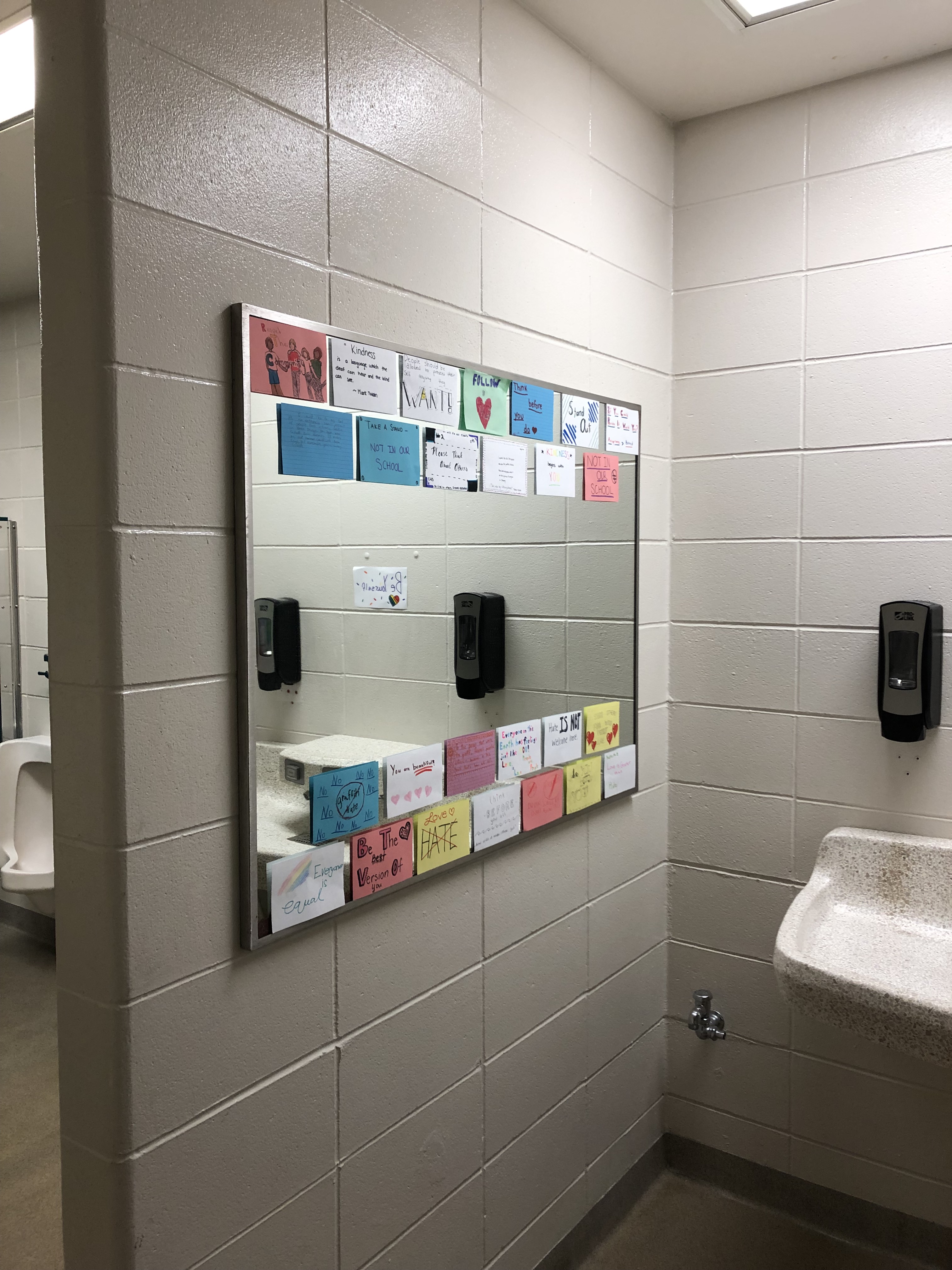Photo: One of the responses made by a student after racist and homophobic graffiti was discovered at the Chenery Middle School.
On the week before Thanksgiving, a bathroom at Chenery Middle School was tagged with racist and homophobic graffiti in an unprecedented attack of hate speech at the school. In response to the act, Chenery Principal Micheal McAllister conducted a school-wide activity to explain what happened and what students can do to begin the healing process. Below is a question and answer with McAllister before the School Committee meeting on Nov. 27.
Q: In your email to parents after the attack, you said you were “stunned” that such an incident took place in Belmont? After two weeks of reflection and knowing that such incidents are happening every day around the country, do you remained as shocked as when first discovered the graffiti?
Yes, I do. I have been here for 20 years and to my knowledge, an attack like this has never happened. I’m not that naive that it has never happened, it just never happened quite on that scale. It was really blatant done with a big thick marker right on the wall and the mirror. Now every middle school in the US has the f-word on the wall or someone says an unkind thing to another student, no one is immune to that. But this was on another, disturbing level.

Chenery Principal Mike McAllister.
Q: Was this incident an example of ingrained racism and homophobia, or was this attention seeking by an immature young teen?
It’s hard to know what the motivation was because there wasn’t a lot of context for it. I have two thoughts on what occurred; that someone was being provocative and writing words they didn’t fully understand and that’s my hope. Or there was real animous to certain students in our school. But it doesn’t necessarily matter what the intent was at some level, it’s more on what the impact is on everyone else. Now that this is out and happened to people, the goal becomes how do you address it.
Where did you turn for guidance to respond to this incident of hate at the Chenery?
Unfortunately, every school is dealing with this, so there were a lot of examples of how schools are approaching the problem. Based on my school committee work in Bedford, Superintendent Jonathan Sills introduced me to the concept of Not in Our Town. It’s based on the Billings’ [Montana] example where the community came together after an act of antisemitism occurred. It’s a school program that says whether you go public or not, you’re making a statement. You’re either tacitly accepting it by remaining quiet or you’re getting out in front of it by saying “Not In Our Town.”
So I think I learned a lot from Superintendent Sills example but I also counseled with friends I have, with certainly my teachers, my assistant principals, and our superintendent [John Phelan]. I never had anyone say, ‘I don’t think you should go public, I don’t think this is a good idea, maybe we should keep this quiet.’
Q. What happened at the Chenery on the day before the Thanksgiving break?
The school has an extended homeroom which is 17 minutes long and on half days we have what we call team days. We asked teachers to set aside for a minimum of the 17 minutes for our response but most teachers gave us almost their entire day. First, we informed students what had happened. Their parents knew of the incident two days earlier so a lot of the children knew. We talked about how we are not the only town dealing with it. We walked them through four different towns in the last week alone that had an incident like ours. We talked about how they felt when they heard about it but also how the targets of this act may have felt and what’s the right way and wrong way to react; what’s helpful and what’s destructive. Finally the concept of Not In Our Town/Not In Our School. We showed them a five-minute clip from Billings about a community not unlike Belmont where something happens to one person and rather just saying, ‘Oh, that’s their problem,’ the entire community stands up and does something.
It wasn’t anything dramatic but it was just a statement that there’s something every one of us can do. And if 1,400 of us in this school does something, that’s better than just one person dealing with the incident.
The most visible activity was student’s writing on squares of construction paper their reaction to the incident.
We gave the students three prompts to write about; how did you feel, the second was what did you want the victims of this to hear, and third, what you want to say to the person who did this. Some kids responded to every prompt, some to one and some just said “I just want to ask ‘why?” Some said the person who did this must have their own problems, and maybe they need some help and our support.
In your email and in the activity, while there is a need for discipline, there is also restorative justice.
There are two types of justice; retributive and restorative. Retributive is the traditional “You did this, now stay after school for detention.” And there is a purpose for that. But there is also a piece of us that says, “When you break it, you have to fix it.” And that requires acknowledging that there’s someone on the other side of what you did. So in this age of smartphones, you might think that you’re only shooting a text message into cyberspace, but on the other side of the screen is a person who receives that. And we have a responsibility to that person. And it’s really easy to forget that for both kids and adults if you look at the trash that’s posted online today.
So we were trying to say on Wednesday was we have a responsibility to each other. Sometimes we make mistakes. We talk with kids a lot about intent versus impact, that sometimes the intent of what you wrote wasn’t clear but the impact was. Intent doesn’t undermine impact. So whether or not you intended to hurt someone, all that matters is that you hurt someone. And now we all have that responsibility to fix it. So that is what we are talking with kids all the time.
I would like to think that someone who wrote that was in school on Wednesday and they wrote something caring. So it was their opportunity to be restorative themselves, in addition, with the help from 1,400 other kids.
Q: What happened that Wednesday was a short-term, a one-day response. What is the long-term solution?
Unfortunately, there isn’t one thing a school can do. The best example to look at is Reading High School which has been dealing with this for a year and a half, especially in the past eight weeks.
For the educators at the Chenery, it’s the continuation of the work that we have been doing. We’ve been talking about culturally proficient teaching that welcomes all cultures into a school. What do we as teachers need to do in order to create an atmosphere where kids don’t leave part of themselves at the school’s front door? So that’s work that has been on-g0ing.
We introduced two tools at the beginning of the school year, the first is called “marking the moment” which is when something provocative or racially charged just happened, you must stop class and address that. It’s no longer acceptable to say to the child ‘be nice because we have algebra to do.’ But sometimes we fail to mark the moment so the second way is the concept called circling back. We can always say to students, “Hey, you said something the other day and it stuck with me and I want to have a chance to talk to you about that.” Because when we don’t say anything, we are still making a statement.
I don’t think that two years ago I don’t know if we would have responded like this nor would we have teachers who would have felt confident enough to respond like this. So I think on some level we’ve been preparing for this. But the work continues. Every single day there is a mark the moment event.
Vigilance is the answer. Sometimes when you make it public, it actually makes it worse. That doesn’t mean its the wrong thing to do. Sometimes it becomes this game of cat and mouse or copycat. But the goal of going public is more than solely to stop the act of hate. It’s also to let other people know that you’re not going to sit back and let it happen. So it’s worth the risk. It’s just a drag that its happening everywhere.





